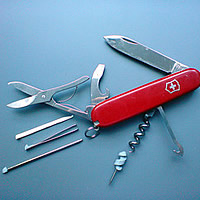Sometimes dramatic innovation comes not from inventing a whole new thing, but rather from rethinking how to use an old thing in a new way. Better still, sometimes the solution to a nagging problem is embedded in the problem itself — again, if we can consider the problem’s components in a different way.
Part of the reason we don’t discover these innovations or solutions is ‘functional fixedness‘ — a cognitive bias that locks us into seeing only the traditional function of an object or process.
Tony McCaffrey in his HBR blog describes the problem of functional fixedness, and suggests some ways to navigate around the bias. The poor victims of the Titanic, for example, might have survived the wait for their rescuers if they had reconsidered the iceberg itself as a lifeboat (it was huge, after all, and wasn’t about to sink). At a smaller scale, we’re surrounded with objects and processes that we consider and use in only limited ways — squandering a world of possibilities that might make our work and life better.
I find that this is not only true with objects but with concepts as well. We divide our organizations by function — marketing, development, operations, administration — and all of us take those functions as absolutes. When, in fact, insights from marketing can transform programming, or operations, or development strategy, and practices for all of these silos can be reconsidered and reused in the others. The same is true for more specific business elements, like capital. We tend to think of the capital controlled by our organization according to its function — facilities, endowment, receivables, cash — rather than understanding the many ways to use and consider each of those elements in advancing our mission. Along another track, I’ve always admired managers who could turn a problem into a solution — like when they encourage a disgruntled audience member to become a passionate volunteer to help solve the problem they identified.
McCaffrey suggests that one way around functional fixedness is to break things down into their generic parts (describing the iceberg as a large floating surface, for example, rather than an iceberg might make alternate uses more obvious). Each object or process then becomes a set of tools or resources that can be applied individually or in new combinations. When your resources are lean and sparse, it just makes sense to use them in any and every way possible.



functional fixedness — an absolutely typical cognitive “ability” we all happen to develop as we age. In the work place, everyone has a title, big or small, it ties into some specific responsibilities and activities. To motivate people (yourself, your boss, your co-worker) to think out of their boxes/comfort zones, and think from a more genetic point of view — is very difficult. If you don’t have boss value the meaning of de-fixedness, from bottom-up, how to truly develop a culture like that in an organization when people don’t see the direct benefits and when everyone is fully occupied with their daily work?
Andrew: Great piece on functional fixedness. I find more and more that patron development, audience development, ticket sales, outreach, education, press, branding and marketing come from one core place. Same information, different methods of distribution. Now one really has to “know the audience you are speaking to.”
Very interesting piece, and so true! Like Michael DiFonzo, we at Young Associates have been encouraging clients to expore and develop shared resources, especially when it comes to gathering, storing and maintaining data — and using it strategically. It’s no good for your fundraisers to build profiles on major donors if your front-line box office folk haven’t a clue who they are… what a missed opportunity! Similarly, think of the quantified data various departments gather — how many, how often, how much. If the data sources can’t be reconciled to each other, you don’t know what you can trust. Here’s to effective collaboration and a unified strategic approach.